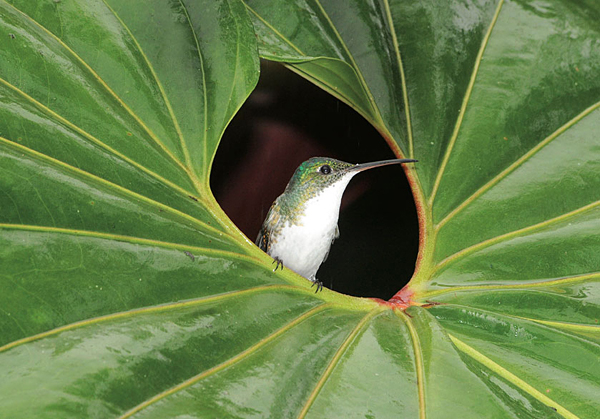 NATURAL SCENES: A photograph of an Andean hummingbird earned recognition for nature photographer Bob Mumford ’57 (Photo: Courtesy of Bob Mumford ’57).
NATURAL SCENES: A photograph of an Andean hummingbird earned recognition for nature photographer Bob Mumford ’57 (Photo: Courtesy of Bob Mumford ’57).Bob Mumford ’57 has never taken a course in photography or the arts. Nor has he ever taken a class in any of the life sciences, either during his time at Rochester or since.
Yet, over several years of disciplined self-study, the one-time history student has combined the rarified knowledge of the naturalist with the fine artist’s eye for detail and composition to become a well-respected nature photographer. In 2008 Mumford claimed his greatest prize yet when he was named a Highly Honored Winner in one of the most prestigious competitions in his field: Nature’s Best magazine’s Windland Smith Rice international photography contest.
The 2008 contest drew over 20,000 applicants across 17 categories. Mumford’s image of an Andean Emerald hummingbird was published in the magazine’s November 2008 issue along with the rest of the 100 award-winning photographs.
He remembers vividly the moment when he took the winning shot. On a trip to Ecuador—home to approximately 1,600 species of birds and 125 of hummingbirds alone—Mumford watched the same bird as she flew off and returned, several times, to her perch on the same leaf, near a small patio outside a lodge in the town of Mindo, the birding center of the Andes. When the pattern was clear, Mumford set up his tripod, waited for the bird’s return, and snapped the picture.
It sounds easy, but comes after many decades of practice. Mumford took his first nature photograph, of a flying, long-eared owl, when he was 9 years old using a small Kodak camera with 127 film—the roll film that’s wound around a spool and protected from exposure by a paper backing. In 1953, he entered the University on a Naval ROTC scholarship and, after his graduation, spent more than 20 years in the service as a strategic planner and over 20 more years running his own management consulting company.
Perhaps that explains why Mumford speaks of his gift for nature photography—fundamentally a solitary vocation—in terms of that infamous product of bureaucratic organization, and staple of office retreats, the Myers-Briggs Personality Test.
“I’m a strong N,” he says, referring to his keen intuition, one of the test’s eight categories of personality traits. Intuition is a skill that comes in handy when you have to read the body language of an approaching grizzly bear, compose the perfect shot of a bird that might fly off in a moment’s time, or capture an Arctic hare’s yawn, as he did in 2002, in an image that resulted in his first major photography award.
“Animals usually have to be relaxed to do something out of the ordinary,” says Mumford. Capturing that unguarded moment may take long periods of patient stalking or silent waiting.
It may also require multiple expeditions. Mumford has visited the home of the yawning hare, a remote northeastern region of Manitoba, 26 times in 13 years. He plans for the finest images from those trips to be compiled into a coffee table book entitled Northern Exposures: Churchill Beyond the Bears. Similarly, in the last five years Mumford has made four trips to East Africa (including a trip to Tanzania to climb Mount Kilimanjaro), and five trips to Ecuador in the last 16 months alone.
Mumford’s photographs have appeared in an array of magazines including National Wildlife, Ranger Rick, and Birders World, and he supplements his income by exhibiting and selling his work. These days Mumford lives a quiet life near Darnestown, Md., a woodsy community outside Washington, D.C., that has so far avoided the encroachment of people and construction that has engulfed much of that region. His life-long concern with environmental conservation has felt increasingly urgent, and the former naval officer’s relationship with the natural world has helped him to become “almost a pacifist.”
Now in his 70s, Mumford has a bright future still ahead. With four more trips to the Andes and the Amazon basin in the works, he expects to follow up on soon-to-be released Northern Exposures with a photographic exploration of Ecuador. He has no plans to slow down.
As he notes, “I’m just getting my second wind.”
